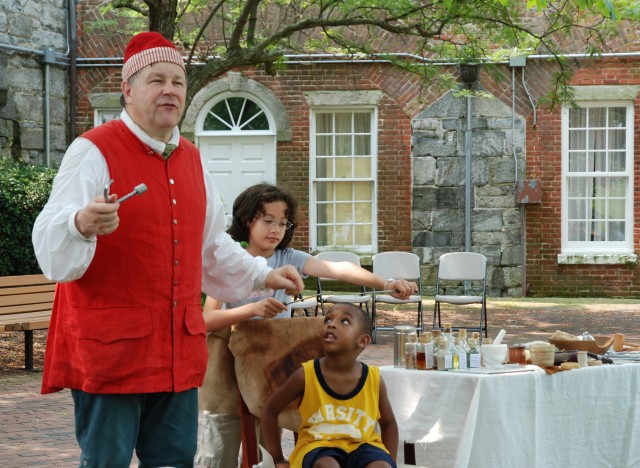FORT MONROE, Va. (TRADOC News Service, July 27, 2009) - The U.S. Army Training and Doctrine Command Surgeon's Office sponsored a Revolutionary War-era medicine re-enactment in support of the Comprehensive Solider Fitness Program for local children and Fort Monroe employees near the Casemate Museum here.
The re-enactment was hosted by TRADOC Command Surgeon Col. Karen O'Brien.
"We can always learn a lot when we go back and look at historical things that happened. One thing that we learn by putting this together is the important role of a comprehensive holistic approach," she said.
The re-enactment team was made up of interns working for the Army during the summer dressed as local residents, TRADOC Surgeon's Office employees, a nurse, and "Dr. Bloodsworth."
Thomas Bertrand played the role of Dr. Thomas Daniel Bloodsworth. He told the audience about medical practices of the time. "The doctor's day would start with a horn blowing to call potential patients," he said. He discussed the similarities between Revolutionary War-era medicine and modern methods.
Bertrand, an educator in the Newport News area, has been visiting school children for years and finds joy in teaching. "I've had many kids that I've seen say, 'Hey, I remember you when you came to my school', and now it's five or six years later," he added.
"One thing I found researching my historical persona, is that many of the things that they did back then are familiar to medical people today," he said. "Many of my instruments I use are still the same, many of the medicines in the form of herbs and spices are still used today in a little different form and a little more effectively. A lot of things they did back then were very good in helping people to get better."
In the hour-long demonstration, he selected children to role-play as surgical attendants and patients, to give a deeper insight into what medical practice was like in the 18th Century. He also mentioned herbs and spices adopted from African and Native American practices to cure and treat illnesses.
"When I'm talking to kids, they learn a great deal when they can compare and contrast," Bertrand said. "Kids tend to retain more when it's hands on."
O'Brien said, "In all of these programs, we see that health was looked at in a very holistic manner and that's something we are getting back to as we move into an era of Soldier fitness which includes spiritual, physical, and emotional [fitness].
The Comprehensive Solider Fitness Program consists of a holistic fitness approach preparing Soldiers, their family members, and Army civilians for complete resiliency. The program will be in full swing in all branches of the Army by 2010.
Through the reenactment, O'Brien said she believes that the best of past practices are still alive today.
"That's all a part of our Comprehensive Soldier Fitness Program to help make our Soldiers more resilient so that they can go the long haul," she said.


Social Sharing